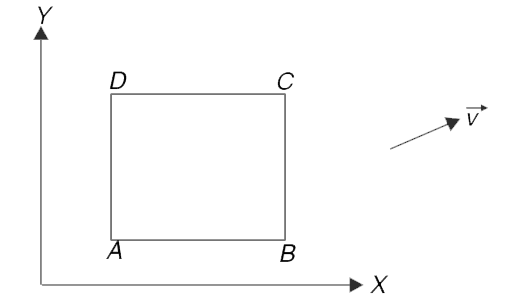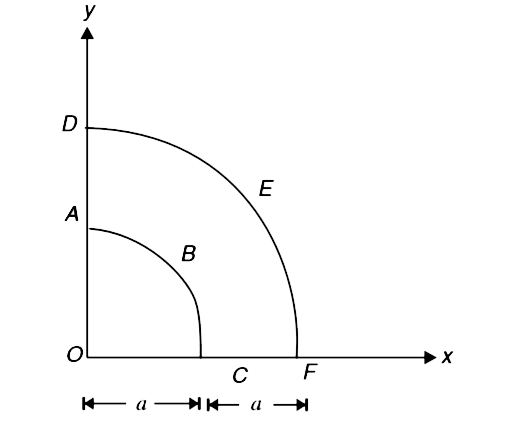A uniform square plate ABCD has mass M side length a. It is sliding on a horizontal smooth surface with a velocity of→v=v0(4ˆi+2ˆj). There is no rotation. Vertex A of the plate is suddenly fixed by a nail. Calculate the velocity of centre of the plate immediately after this

The correct Answer is:vc=3v04(ˆi−ˆj)
Step by step video, text & image solution for A uniform square plate ABCD has mass M side length a. It is sliding on a horizontal smooth surface with a velocity ofvec(v) = v_(0) (4 hat(i) + 2 hat(j)). There is no rotation. Vertex A of the plate is suddenly fixed by a nail. Calculate the velocity of centre of the plate immediately after this by Physics experts to help you in doubts & scoring excellent marks in Class 11 exams.
Updated on:21/07/2023Topper's Solved these Questions
Similar Questions
ABCFED is a uniform plate (shown in figure). ABC and DEF are circular arcs with common centre at O and having radii a and 2a respectively. This plate is lying on a smooth horizontal table. A particle of mass half the mass of the plate strikes the plate at point A while travelling horizontally along the x direction with velocity u. The particle hits the plate and rebounds along negative x with velocity u2 . Find the velocity of point D of the plate immediately after the impact. [Take 289π≅1 ]

View SolutionA 150 g mass has a velocity →v=(2ˆi+6ˆj)m/s at a certain instant. What is its kinetic energy?
View Solution
Knowledge Check
A uniform square plate ABCD has mass M side length a. It is sliding on a horizontal smooth surface with a velocity of→v=v0(4ˆi+2ˆj). There is no rotation. Vertex A of the plate is suddenly fixed by a nail. Calculate the velocity of centre of the plate immediately after this
 Av0(2ˆi+4ˆj)B3v04(−ˆi)+3v04ˆjC3v02ˆi−3v02ˆjD3v0ˆi−3v0ˆj
Av0(2ˆi+4ˆj)B3v04(−ˆi)+3v04ˆjC3v02ˆi−3v02ˆjD3v0ˆi−3v0ˆjA surface has the area vector →A=(2ˆi+3ˆj)m2 . The flux of an electric field through it if the field is →E=4ˆiVm :
A8 V - mB12 V - mC20 V - mDzeroAn electron of charge −e, mass m, enters a uniform magnetic field →B=Bˆi with an initial velocity →v=vxˆi+vyˆj. What is the velocity of the electron after a time interval of t seconds?
Avxˆi+vyˆj+emvyBtˆkBvxˆi+vyˆj−emvyBtˆkCvxˆi+(vy+emvyBt)ˆjD(vx+emvyBt)ˆi+vyˆj
A particle of mass m moves in the xy-plane with velocity of →v=vxˆi+vyˆj. When its position vector is →r=x→i+y→j, the angular momentum of the particle about the origin is.
View SolutionA smooth sphere is moving on a horizontal surface with velocity vector 3ˆi+ˆj immediately before it hits a vertical wall. The wall is parallel to the vector ˆj and the coefficient of restitution between the wall and sphere is 13. The velocity vector of the sphere after it hits the wall is :-
View SolutionTwo particles of equal masses have velocities →v1=4ˆiand→v2=4ˆj . First particle hac an acceleration of the other particle is zero . The centre of mass of the two particles moves in a path of
View SolutionA motor boat is going in a river with a velocity →V=(4ˆi−2ˆj+ˆk)ms−1. If the resisting force due to stream is →F=(5ˆi−10ˆj+6ˆk)N, then the power of the motor boat is
View SolutionA portion is fired from origin with velocity →v=v0ˆj+v0ˆk in a uniform magnetic field →B=B0ˆj. In the subsequent motion of the proton
View Solution
